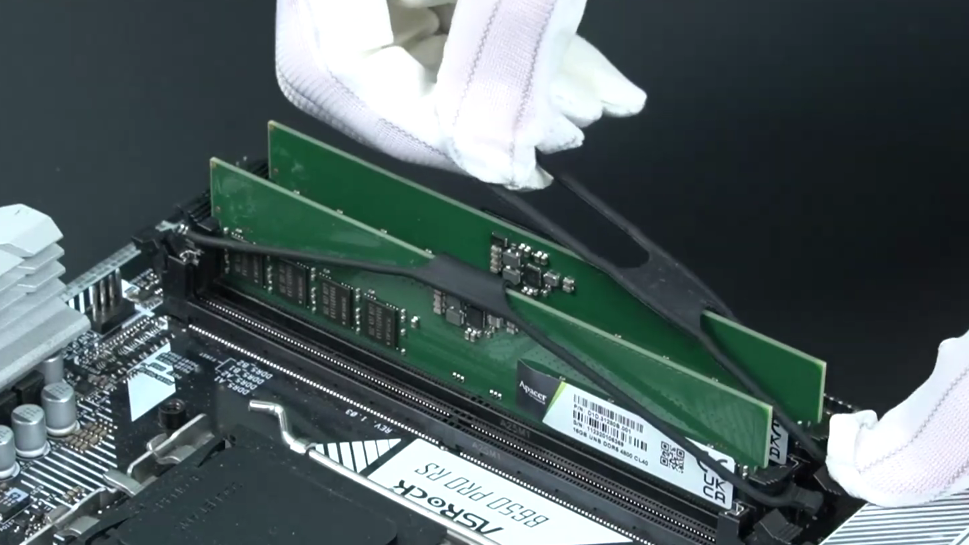Buckle up! Apacer launches seat belt for RAM sticks — protection for DIMMs from vibration damage

Apacer has announced a new solution for DIMM modules that won’t stay in place: rugged retention straps for RAM that keep DIMMs secure from even the highest-intensity vibrations.
Marketed towards “Edge AI” use cases, which include long-distance transport or vibration-sensitive implementations, the retention straps work by holding down DIMMs with three points of contact: two at the anchor points holding the DIMM retention arms tight to the DIMM and a third on the top and center of the DIMM. Apacer claims this three-point method beats competitors’ two points of contact, which is assumed based on squeezing the retention arms tight to the RAM.
This RAM seatbelt is made of a flame-retardant polysiloxane (silicone), which claims durability at the intense high and low ends of the thermometer, up to 200 degrees Celsius. It has also been tested to meet military-grade certifications MIL-STD-833K and MIL-STD-810G for shock and vibration resistance. Apacer’s RAM straps are compatible with all modern motherboards and will play nicely with UDIMM, RDIMM, or ECC UDIMM modules, ensuring a good fit for any deployment.
Besides the risk of losing the SEO battle to automotive “RAM seatbelts,” Apacer’s new RAM straps are an exciting novelty that may see serious use. The potential for getting lost in the sands of Google may be why Apacer seems to have leaned heavily on overusing today’s favorite marketing buzzwords like “Edge AI” and “IoT applications” like intelligent cities or self-driving fleets. Marketing to the AI market pays off, though; it’s been recently estimated that the AI industry is spending $600 billion annually on hardware, meaning advertisers are heavily incentivized to slap “AI” onto every tech product, no matter how non-electronic.
Apacer’s move to release its rugged security straps is a good sign for those concerned that the RAM market will move swiftly away from the traditional SO-DIMM form factor. The CAMM2 form factor is a new kid on the block set to hit shelves before Christmas and takes RAM from the classic tall and scalable SO-DIMM modules we’ve had for decades to a flat module that mounts parallel to motherboards, stands only millimeters high, and screws into place. The new form factor will play in laptops and consumer PCs as a super-high-speed replaceable option, but CAMM2 is not expected to replace SO-DIMM soon. Enterprise and consumer solutions like servers will keep SO-DIMM on shelves for a while thanks to its easier replaceability, smaller board footprint, and higher scalability.
Get Tom's Hardware's best news and in-depth reviews, straight to your inbox.

Sunny Grimm is a contributing writer for Tom's Hardware. He has been building and breaking computers since 2017, serving as the resident youngster at Tom's. From APUs to RGB, Sunny has a handle on all the latest tech news.
-
Notton Is this a real problem? Because when I look up "ram knocked loose during transport", 100% of the search results are for the pickup truck.Reply -
Krieger-San Reply
Former systems builder here - no it really isn't.Notton said:Is this a real problem? Because when I look up "ram knocked loose during transport", 100% of the search results are for the pickup truck.
The only time we'd ever see RAM not fully seated was due to a phenomenon called 'chip creep'. This refers to the 'creepage' of circuit boards that are connected to a motherboard that experience heating and cooling cycles very regularly (more than once a day, for several years). Heating and cooling creates expansion and contraction of the two separated boards at different rates, which creates a microscopic movement between the boards. Over time, they will eventually creep out of the socket.
This is a rare condition, and personally, I feel like this is just a waste of materials. What would make so much more sense to me would be to re-introduce the dual latch DIMM slots again instead of those ultra cheap one-sided latching DIMM slots. The whole point of the dual latch was to prevent chip creep by physically holding the DIMM with a plastic latch perpendicular to the board, creating a physical brace to prevent the board from lifting out of the DIMM slot.
P.S. - You almost always see dual latch DIMM slots on server hardware, where they don't skimp as much. -
hotaru251 the ram lock mechanism is arguably the strognest "hold" in a system outside stuff actually screwed down.Reply
look at the amount of force it takes to seat em and tell me thats coming lose if done properly :| -
eichwana In the 20 years I’ve built and shipped computers, I’ve never seen RAM come loose during shipping.Reply
Heavy graphics cards and CPU coolers yes, but not RAM.